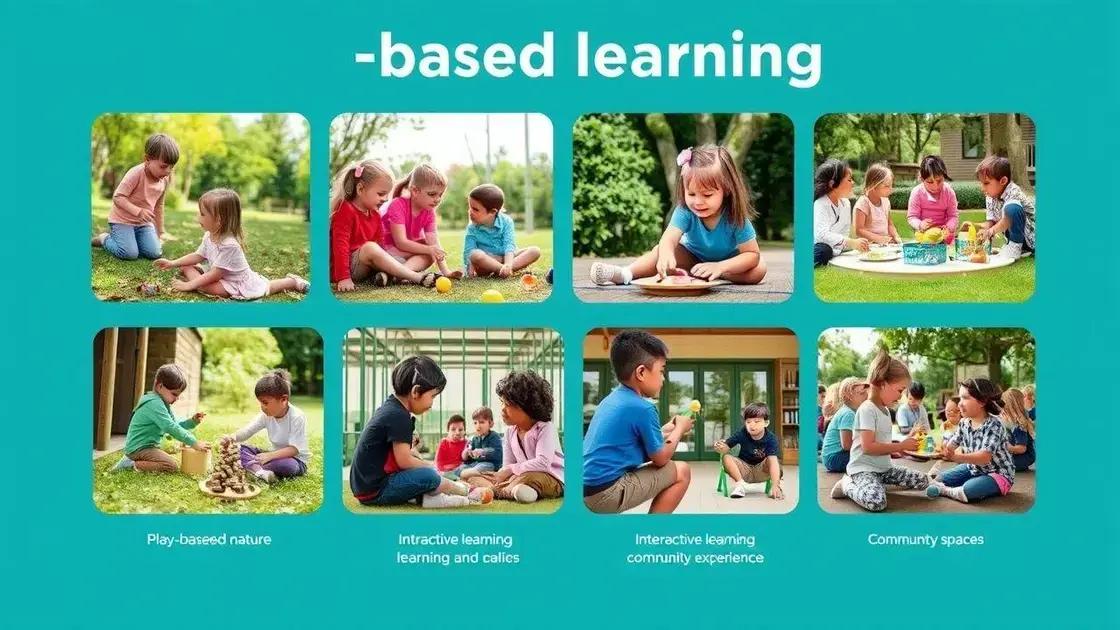Early childhood learning through play-based models

Early childhood learning through play-based models enhances cognitive, social, and emotional development, allowing children to explore their interests in a fun and engaging way, which prepares them for lifelong success.
When we talk about early childhood learning through play-based models, it’s fascinating how much children can gain from a fun approach. Have you ever thought about the skills your kids develop while playing? Let’s dive into this engaging topic.
Understanding play-based learning
Understanding play-based learning is essential for grasping how children develop crucial skills. This approach emphasizes the significance of play in early childhood education. When children play, they are not just having fun; they are also learning important concepts and skills that will serve them throughout their lives.
The key to play-based learning lies in allowing children the freedom to explore their interests. It encourages creativity, problem-solving, and critical thinking abilities. When children engage in play, they are able to express themselves and interact with others in meaningful ways.
Core Principles of Play-Based Learning
There are several core principles that define play-based learning:
- Children learn best through hands-on experiences.
- Play should be child-led, allowing their interests to guide learning.
- It fosters social-emotional development and self-regulation.
In addition to these principles, it’s vital to understand that play-based learning incorporates various types of play, such as pretend play, constructive play, and games with rules. These different forms of play can enhance various skills. For instance, pretend play helps with imagination and narrative skills, while constructive play promotes spatial awareness and fine motor skills. By providing opportunities for all types of play, caregivers can create enriching environments that boost learning.
Benefits of Play-Based Learning
The benefits of play-based learning are manifold:
- Enhances cognitive abilities through interactive engagement.
- Encourages social skills by fostering collaboration and communication.
- Builds resilience as children navigate challenges during play.
- Promotes a lifetime love of learning by making education enjoyable.
As children immerse themselves in these playful experiences, they develop a sense of curiosity and an eagerness to learn. This foundation will benefit them not just in school, but throughout their entire lives. Investing in play-based learning strategies allows parents and educators to nurture well-rounded individuals.
Benefits of play in early childhood education

The benefits of play in early childhood education are extensive and impactful. Play is not just fun; it is a crucial element in the development of young children. Through play, children build skills that are essential for success in school and beyond. Engaging in playful activities allows children to explore their world while also promoting learning.
One of the primary advantages of play is that it enhances cognitive development. When children play, they experiment with concepts of cause and effect. They learn to solve problems and think critically. For example, while building with blocks, children understand balance and gravity, developing their reasoning skills.
Emotional and Social Growth
In addition to cognitive growth, play also promotes significant emotional and social development:
- Play helps children express their feelings and understand the emotions of others.
- It fosters cooperation and teamwork skills as children learn to share and take turns.
- Through role-play, they can navigate different social scenarios and develop empathy.
Furthermore, play in early childhood education offers children opportunities to develop their motor skills. Activities that involve movement, such as running or climbing, improve coordination and physical health. Even fine motor skills, such as those used for writing, benefit from play with small objects or art supplies.
Long-Term Academic Success
Research shows that children who engage in play-based learning often perform better academically. They tend to be more enthusiastic about learning and exhibit greater creativity later on. Because play nurtures a love for learning, children are more likely to engage in school positively. As they transition to formal education, their play-based experiences support their ability to adapt and thrive.
With the myriad of benefits that play brings to early childhood education, it’s clear that the value of play cannot be overstated. Parents and educators should embrace play as a vital part of the learning process. This approach not only prepares children for academic success but also allows them to grow socially and emotionally.
Implementing play-based models at home
Implementing play-based models at home can significantly enhance your child’s learning experience. By creating a playful environment, you allow them to explore and experiment with different concepts while enjoying the process. This approach not only makes learning fun but also encourages curiosity and creativity.
To start, consider setting up specific areas in your home dedicated to various types of play. For example, a designated space with building blocks can inspire constructive play, where children learn about balance and design. In another area, arts and crafts supplies can foster creative expression.
Encouraging Child-Led Play
One effective way to implement play-based models is to encourage child-led play. Allow your child to choose activities based on their interests. This empowers them and helps develop decision-making skills. You could ask guiding questions like, “What would you like to build today?” or “How can we decorate this together?” These interactions make learning personal and meaningful.
- Provide a variety of materials for open-ended play.
- Rotate toys and resources to keep play exciting.
- Observe your child’s play to understand their interests better.
Additionally, as you engage in play with your child, ask them open-ended questions. For example, when building something together, you can ask, “What happens if we add another block here?” This encourages critical thinking and problem-solving as they explore different outcomes.
Incorporating Learning into Daily Activities
Play-based learning can also extend beyond toys and designated play areas. Incorporating learning into everyday activities is another effective method. Cooking together can teach measurement and following directions, while shopping can introduce concepts of counting and budgeting.
During these activities, make sure to highlight the learning moments. Highlighting these connections reinforces the idea that learning is everywhere, not confined to a classroom. As you implement play-based models at home, remember that the goal is to create a nurturing space where learning flourishes through play.
Real-world examples of successful play-based learning

Real-world examples of successful play-based learning illustrate how effective this approach can be in various educational settings. Many schools and programs around the world have adopted this model, transforming the way children engage with learning.
For example, in a school in Reggio Emilia, Italy, teachers encourage children to explore their environment freely. The curriculum is designed around the children’s interests, allowing them to pursue projects that inspire them. When exploring their community, children might collect natural materials to create art, learning about nature and their surroundings in the process.
Outdoor Learning Adventures
Another great case comes from Forest Schools in Scandinavia. Here, children spend significant time outdoors, engaging with nature through play. This environment fosters physical development and boosts social skills as children work together to navigate challenges. They might build shelters or learn about wildlife while developing teamwork skills.
- Children learn resilience by facing outdoor challenges.
- Activities build confidence and independence.
- Exposure to nature enhances creativity and cognitive skills.
In the United States, schools like the New York City-based “The Play Academy” integrate play-based models into their curriculum. Teachers craft engaging learning experiences that blend play with academics. Children might use storytelling to build social studies lessons, weaving narrative into their understanding of history.
Community Involvement
Many successful examples also involve community participation. Programs like “Playful Learning Landscapes” invite local communities to create playful learning environments in parks and public spaces. These setups encourage children to learn through playful interactions outside of traditional classrooms. Activities such as scavenger hunts or interactive exhibits engage children and parents, strengthening the community while promoting learning.
The implementation of play-based learning in real-world settings demonstrates its effectiveness in promoting holistic child development. By observing these examples, educators and parents alike can draw inspiration and incorporate elements of play into their own educational practices.
In conclusion, embracing play-based learning offers numerous benefits for early childhood education. By fostering creativity, social skills, and emotional growth, this approach prepares children for lifelong success. Real-world examples show how effective and engaging play can be, making learning an enjoyable experience. Parents and educators can easily implement play-centered activities at home and in schools. Ultimately, creating playful learning environments empowers children to explore, discover, and develop essential skills for their future.
FAQ – Frequently Asked Questions about Play-Based Learning
What is play-based learning?
Play-based learning is an educational approach that uses play as the primary method for children to learn and develop skills in a fun and engaging way.
How does play-based learning benefit children?
It promotes cognitive, social, and emotional development, enhancing creativity, problem-solving skills, and helping children build important relationships.
Can play-based learning be implemented at home?
Yes! You can create play-friendly environments at home with simple activities like building with blocks, arts and crafts, or outdoor exploration.
What are some examples of successful play-based learning programs?
Programs like Reggio Emilia in Italy and Forest Schools in Scandinavia highlight how effective play-based models can be in fostering holistic child development.





